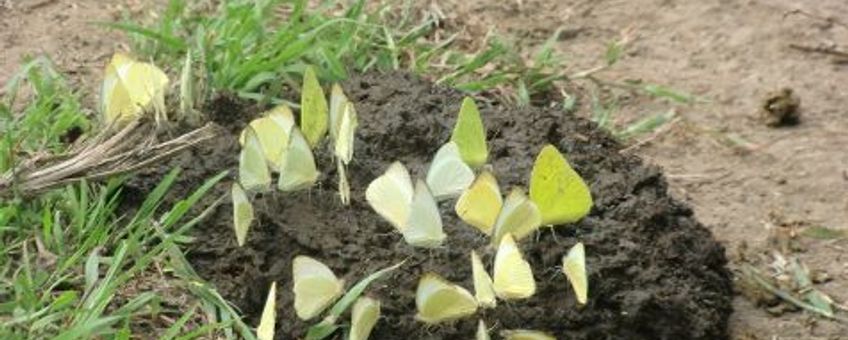
Vlinders van St. Eustatius, Saba and St. Maarten
Bericht uitgegeven door Dutch Caribbean Nature Alliance (DCNA) [land] op [publicatiedatum]
Vlinders vormen een gevarieerd en interessant onderdeel van de biodiversiteit van de Antillen en zijn mede verantwoordelijk voor de status als wereldwijde ‘hotspot’ voor biodiversiteit. Van de 112 genera die voorkomen op de eilanden, bevatten er 59 één of meer endemische soorten. In totaal zijn er 285 vlindersoorten bekend van de Antilliaanse eilanden, waarvan er maar liefst 45 procent alleen op deze eilanden voorkomt. De meeste van deze endemen kan men tegenkomen op de grotere en hoger gelegen eilanden, zoals Cuba, Hispaniola en Jamaica. De biogeografie van vlinders blijft voor velen een interessant, en daardoor actief, studiegebied, niet alleen omdat de Caribische fauna relatief goed gedocumenteerd is, maar ook omdat de eilanden een complexe biogeografische historie hebben, evenals een rijk scala aan ecologische processen, zoals isolatie, immigratie, differentiatie, soortenvorming en uitsterving, die ook in de toekomst de biodiversiteit in de regio vorm zullen blijven geven.
Lees verder in het Engels…
Butterflies form a varied and interesting component of the biodiversity of the Antilles and contribute significantly to their status as a planetary hotspot of biodiversity. Of the 112 genera present in the islands, 59 have one or more endemic species. There are a total of 285 species present in the Antillean islands, of which 45% are endemic. Most of these are centred around the larger and higher islands of Cuba, Hispaniola and Jamaica. Butterfly biogeography remains an interesting and active area of study, not only because the Caribbean fauna is relatively well-documented but also because the West Indies present an area with a complex biogeographic past as well as a rich gamut of ongoing ecological processes such as isolation, immigration, differentiation, speciation, and extinction that will continue to shape the biodiversity of the region for times to come.

For five years Hannah Madden, park ranger of STENAPA, monitored the common butterflies of St. Eustatius annually during the months of January-April in four distinct habitats. Her last collection took place early 2013. All her data are now being combined with earlier collection data by Dr. Miller and Anna Rojer for St. Eustatius, Saba and St. Maarten to provide an update and full assessment of the butterflies of the three Dutch islands.
The findings are proving to be very interesting. First of all, the four different habitats on St. Eustatius proved to have markedly different butterfly faunas. These differences are consistent with what is generally known about the habitat requirements of the various species. For instance, The Quill showed notably highest representation of both nymphalids and heliconiids than the drier and windier habitats of The Mountains and the coastal northeast flanks of the Quill. Lycaenids were notably absent inside the Quill crater while hesperids were more or less equally successful in all four contrasting habitats. Pierids were also well-represented in all habitats but tended to be more abundant in the lower dryer and windier habitats of The Mountains and the lower coastal northeast flank of the Quill.

The same contrasts also hold for individual species. For instance, Anaea minor was a species notably most strongly associated with the Quill. Densities in The Mountains area and in the still and humid Quill crater were a factor of four or more lower. Both Biblis hyperia and Heliconius charitonia were especially concentrated in the most wind-sheltered areas of the Quill, while Ephriades arcas was a hesperiid that was most important inside the Quill crater. New species records for Statia were also documented. These include Hypolimnas missipus and Papilio demoleus. Hypolimnas missipus occurs primarily in the Mountains area and was most seen on Gilboa and Signal Hill. The males are easier to spot than the females, though a female was also seen once on Gilboa Hill. Papilio demoleus is a recently introduced exotic species and was only found in the Lower Town area of the St. Eustatius port, with larvae on the limeberry, Triphasia trifolia. This plant of tropical southeast Asia has been introduced in tropical regions around the world for its edible berries. Papilio demoleus is relatively new to the Caribbean, but is gradually spreading. It is a known pest of citrus crops. The species may have come along to the region with imported crop plants. Island endemics are often vulnerable and rare. However, in November 2012 Debrot found the Lesser Antillean endemic butterfly Wallengrenia ophites to be abundant in the coastal areas of Venus Bay, Statia. Such abundance provides excellent opportunities to study the ecology of this poorly-known island endemic.

The butterfly species lists for St. Eustatius, Saba and St. Maarten now amount to 30, 28 and 25 species respectively. The total number of species documented for the three islands is: 39. This compares to a total of 61 species for all Leeward islands combined. Of the latter four are endemic species, nine endemic subspecies and one endemic genus. Three of the four lesser Antillean endemics are represented in the three Dutch Caribbean islands. Cluster analysis shows that the faunas of Saba and St. Eustatius cluster more closely with that of Nevis while the fauna of St. Maarten shares greatest similarity to the fauna of Anguilla, St. Barts and Barbuda.
The authors soon expect to submit the full study to a scientific journal for formal publication.
Read the entire article in BioNews
Text: Adolphe O. Debrot, Hannah Madden, Leontine E. Becking, Anna Rojer and Jacqueline. Y. Miller
Photos: Adolphe O. Debrot, IMARES Wageningen UR; Hannah Madden, STENAPA
Nederlandse inleiding: Paul Westerbeek, Dutch Caribbean Nature Alliance (DCNA)
